Tag: art
Fiat lux! Helsinki lit
9 January 2014 | This 'n' that
 When there’s no snow in January, as is the case this year, the darkness does make Helsinki appear somewhat joyless. This year Canada and parts of the United States got more than a taste of freezing Arctic temperatures – but at the time of writing winter is still postponed in the lower half of Finland.
When there’s no snow in January, as is the case this year, the darkness does make Helsinki appear somewhat joyless. This year Canada and parts of the United States got more than a taste of freezing Arctic temperatures – but at the time of writing winter is still postponed in the lower half of Finland.
A temporary relief was brought by Lux Helsinki – staged now for the sixth time – as light, colour and sound made the capital brighter and more beautiful between 4 and 8 January.
The core of the city, the Cathedral, was adorned by a large heart placed at the top of the steps, beating in colours to music.
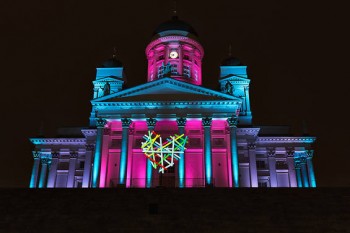
Corazón by Agatha Ruiz de la Prada. Photo: Marina Okras
Corazón, by the Madrid-born artist and fashion designer Agatha Ruiz de la Prada, in collaboration with the production and design company D-Facto, reflects her design themes of love and happiness.
One of the participants in Lux Helsinki was Unen ääret / Edges of Dreams: projected on to the façade of the Hakasalmi Villa (1843–46), between the Finlandia Hall and the Music House, it was inspired by the history of the building and its inhabitants. Now a museum, it became known as the home of a benefactor of the city, a rich and famous woman of her time, Aurora Karamzin from the 1860s to the 1890s.

Hakasalmi Villa: Edges of Dreams by Mika Haaranen. Photo: Lauri Rotko
The building was seen through dreamlike visions formed by painted films and shadow patterns by Mika Haaranen, a lighting and set designer and photographer. His works extend from the world of theatre and musicals to contemporary dance, concerts and film. The accompanying music was composed by Aake Otsala.
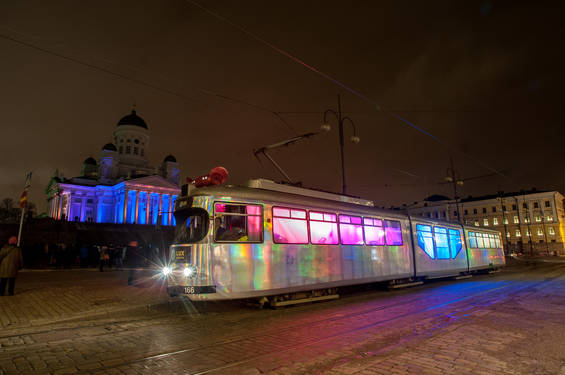
Lux Tram by students of lighting and sound design, Theatre Academy. Photo: Hannu Iso-Oja
Helsinki trams have been transporting citizens from 1891. One of the trams was transformed into a moving light installation by the use of programmable LED floodlights. The work was designed and realised by the Theatre Academy of the University of the Arts Helsinki lighting design students Riikka Karjalainen and Alexander Salvesen. A pity it was not possible to hop on…
Truth or hype: good books or bad reviews?
8 November 2013 | Letter from the Editors
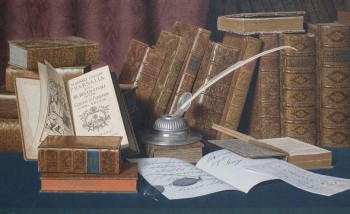
‘The Bibliophile’s Desk’: L. Block (1848–1901). Wikipedia
More and more new Finnish fiction is seeing the light of day. Does quantity equal quality?
Fewer and fewer critical evaluations of those fiction books are published in the traditional print media. Is criticism needed any more?
At the Helsinki Book Fair in late October the latest issue of the weekly magazine Suomen Kuvalehti was removed from the stand of its publisher, Otavamedia, by the chief executive officer of Otava Publishing Company Ltd. Both belong to the same Otava Group.
The cover featured a drawing of a book in the form of a toilet roll, referring to an article entitled ‘The ailing novel’, by Riitta Kylänpää, in which new Finnish fiction and literary life were discussed, with a critical tone at places. CEO Pasi Vainio said he made the decision out of respect for the work of Finnish authors.
His action was consequently assessed by the author Elina Hirvonen who, in her column in the Helsingin Sanomat newspaper, criticised the decision. ‘The attempt to conceal the article was incomprehensible. Authors are not children. The Finnish novel is not doing so badly that it collapses if somebody criticises it. Even a rambling reflection is better for literature than the same old articles about the same old writers’ personal lives.’ More…
In good company
18 October 2013 | This 'n' that

Portrait of an artist: Joel Lehtonen, sketched by Pietro Annigoni in Florence, 1931. Picture: literary archives of the Finnish Literature Society
Margaret, Countess of Snowdon (Princess Margaret, 1930–2002), Joel, Master of Putkinotko (1881–1934), and Philip, Duke of Edinburgh (born 1921) met in the same museum case in Florerence in October, when an exhibition of the work of the artist Pietro Annigoni (1910–1988) was opened.
The morganatic juxtaposition of the English royals and the Finnish writer is based on Annigoni’s reputation as one of the best-known portraitists of the 20th century, in whom the royal courts of England and Denmark, among others, placed their trust.
Joel Lehtonen, author of the novel Putkinotko (‘Hogweed Hollow’, the name also refers to a place) and classic of Finnish literature, is included on account of the fact that, in celebrating his fiftieth birthday in Florence in 1931, he partied throughout the night with students from the Accademia di Belle Arte ‘to the rhythm of an excellent Chianti’.
Also present was the young Piero Annigoni, who, in a cellar restaurant, took out his working tools. A red-chalk portrait of Lehtonen was the result, along with a series of dancing girls drawn in Indian ink. ‘It was five in the morning before I realised,’ Lehtonen wrote back to Finland.
Lehtonen had already spent a year in Italy in 1908 translating Boccaccio’s The Decameron, which, to his annoyance, was censored by the publisher. He published a volume of poetic prose based on his Italian experiences, Myrtti ja alppiruusu (‘The myrtle and the rhododendron’), of which one section is dedicated to Florence, that ‘glittering, passionate city of the spirit’.
Young Florentine artists were used to world-class artists. When the poet Dylan Thomas visited the city in the 1940s, the poet and author Luigi Berti – an acquaintance of Lehtonen’s – complained that ‘poets travelling in Italy no longer give themselves the airs of “milords” – behave like Lord Byron.’ Lehtonen, however, was able to party stylishly and thoroughly in a way that appears to have pleased the sons of Florence.
As he set off on the return journey to Finland, Lehtonen wrote to his wife: ‘An embarrassing day is over’, ‘I am in fine spirits! Heat the sauna.’ He brought with him Annigoni’s works, which are now in the archive of the Finnish Literature Society.
The curator of the Florence exhibition found more sketches of Lehtonen in the Museo Annigoni: in the current show, they are placed alongside sketches of Princess Margaret and Prince Philip.
The opening of the exhibition, in the premises of the Ente Cassa di Risparmio di Firenze, was attended by 300 of the city’s elite. It was as if the nobility of the portraits of the Uffizi art gallery had stepped out of their frames to honour Annigoni, whose paintings continued the traditions of the renaissance. The Corriere della Sera and La Repubblica gave prominent coverage to the event. The young politician and Florence mayor Matteo Renzi said in his speech that in northern Italy Annigoni’s significance to art is parallel to that of Olivetti to industry.
Annigoni’s early portraits of Lehtonen are shown in a section entitled Opere rare o inedited. The 240-page catalogue also includes brief description of Lehtonen as a writer and an account of that night in Florence in 1931.
Translated by Hildi Hawkins
A rare bird from Fancyland
20 August 2013 | Reviews

Bead-covered curlew, 1960. Height ca. 115 cm, Collection Kakkonen. Photo: Niclas Warius
Harri Kalha:
Birger Kaipiainen
Helsinki: Suomalaisen Kirjallisuuden Seura (The Finnish Literature Society), 2013. 249 p., ill.
(Summaries in Swedish and English)
ISBN 978-952-222-457-6
€46, hardback
Ceramics confectioner. Degenerate aristocrat. Ornamental criminal. These epithets can be found in Birger Kaipiainen, a new, full-length study of the ceramic artist by art historian Harri Kalha.
Throughout his artistic career Birger Kaipiainen (1915–1988) worked with forms, subjects and methods that were unfamiliar in the field of traditional ceramics, at least in mid-20th-century Finland, and made use of fantasy and ornament. As a ‘porcelain painter’ he showed little interest in the technical challenges of clay – although in his ceramic creations Kaipiainen explored three-dimensional form, montage, colour, texture and the tactile dimensions of the medium. More…
Elitist versus pop?
8 August 2013 | Letter from the Editors

An elitist of his time? A caricature of Richard Wagner by Leslie Ward, published in Vanity Fair in 1877 (caption read ‘The Music of the Future’). Picture: Wikimedia
The old phrase ‘art for art’s sake’ has begun to sound like an appeal instead of an bohemian creed, without any negative ambiguity. Please let art be created for art’s sake!
In our times of neo-liberal ideologies, the criteria for assessing art include its capacity to generate profits to creative industries, to have export value, to be of assistance to business in general. But art, in essence, serves no ideology.
Technology now allows us to be more entertained than ever before, if we so choose. Art and entertainment alike come to us by the use of various devices. What has often been called ‘elitist’ art – opera, modern music, ballet – can be enjoyed lying on the sofa in the home. Money is not an obstacle.
Art, too needs money, of course: orchestras, theatres, training of artists and artists themselves need subsidies from society. Entertainment is by nature profitable business, as it attracts and involves large paying audiences. Smaller audiences want to listen to classical music, read books and see films that are not made solely in order to bring in as much money as possible. But why should these forms of art be called ‘elitist’? More…
Art Deco / ja taiteet / i konsten / and the arts
6 June 2013 | Mini reviews, Reviews
 Scientific editor: Laura Gutman
Scientific editor: Laura Gutman
Editor: Susanna Luojus
Helsinki: Suomalaisen Kirjallisuuden Seura (the Finnish Literature Society), 2013. 179 p., ill.
Texts in Finnish and Swedish, summaries in English
ISBN 978-952-222-430-9
€38, hardback
This work was published simultaneously with the opening of the exhibition ‘Art Déco and the Arts. France–Finlande 1905–1935’, running at the Amos Anderson Art Museum in Helsinki from March to 21 July. Antiquity was the primary source of inspiration for this broad artistic movement in France, after the breakthrough of Fauvism in 1905. In Finland this antimodern – and yet at the same very modern – movement manifested itself most clearly in industrial art, in the 1920s in classicism and 1930s in functionalism. But from early on, Finnish painters and sculptors also kept an eye on the French art and artists – among them Maurice Denis, the spokesman of the antimodernists. The dialogue between the visual and the performative arts (theatre and dance) in Finland is also examined. Samples of Art Deco architecture are mostly absent, as the emphasis is on painting and sculpture. Some less well-known artists of the period (painter Nikolai Kaario, sculptor and engraver Eva Gyldén) are introduced. The exhibition and the richly illustrated book introduce both Finnish and French works – from many museums and collections in France – of both industrial and fine arts, in pictures and in words by nine specialists, offering the reader fresh and interesting comparisons.
Valokuva taiteeksi. Photography into Art. Hannula & Hinkka -kokoelma / Collection
30 May 2013 | Mini reviews, Reviews
 Valokuva taiteeksi. Photography into Art. Hannula & Hinkka -kokoelma / Collection
Valokuva taiteeksi. Photography into Art. Hannula & Hinkka -kokoelma / Collection
Toimituskunta [Edited by] Erja Hannula, Jorma Hinkka, Sofia Lahti, Tuomo-Juhani Vuorenmaa
English translation: Jüri Kokkonen
Helsinki: Aalto University School of Arts, Design and Architecture, Aalto ARTS Books (Musta Taide 4/2012; publication series of The Finnish Museum of Photography 44.) 209 p., ill.
ISBN 958-952-292-000-3
€33.90, hardback
It has been typical of Finland that it lacks collections of international photography, private or public. In the politically turbulent 1970s interest in photography began to grow. The Hippolyte Gallery, run by artist Ismo Kajander, exhibited international photography by Diane Arbus, Eugène Atget and Édouard Boubat, among others. The graphic designer Jorma Hinkka (also Art Director of Books from Finland, 1998–2006) began making posters for Hippolyte ‘out of pure enthusiasm’, and designing books by Finnish photographers, among them Pentti Sammallahti, Ismo Hölttö, Jorma Puranen and Merja Salo. As a result of spending so much time with ‘the black art’ (as it was called by a Finnish pioneer of photography, I.K. Inha, in 1908), Hinkka and his art director spouse Erja Hannula began to collect samples of it. After 30 years, in 2012, they donated more than two hundred photographs by almost a hundred artists to The Finnish Museum of Photography. The social status of the black art has risen considerably since the 1970s, as has professionalism in the field. This book presents excellent reproductions of the collection of photos, taken within a century and a half; the variety of styles and subjects chosen surprise with its richness.
Becoming Finland
23 May 2013 | Reviews
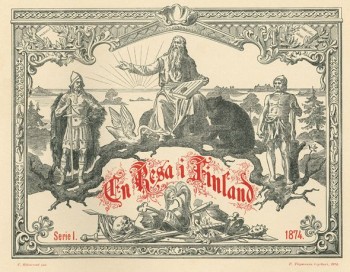
Imaginary heroes: the title page of En resa i Finland. Illustration by C.E. Sjöstrand (1828–1906)
Zacharias Topelius
En resa i Finland
[A journey in Finland (1873)]
Helsinki: Svenska litteratursällskapet i Finland, 2013. 173 p., ill.
Utgivare [Editor]: Katarina Pihlflyckt
ISBN 978-951-583-260-3
€38, hardback
(Stockholm: Atlantis förlag, 2013. ISBN 978-91-7353-616-5)
The birth of Finland as a country came as a surprise to those who lived there.
It was created by Napoleon and Alexander I, becoming a reality following Russia’s victory over Sweden in the so called Finnish War. In 1809 Alexander exalted Finland as ‘a nation among nations’, however the new nation still needed to feel like a nation. The Russian rulers supported gentle and non-political nationalism in Finland, in the hope that it would mentally distance the country from Sweden. In this tranquillity, the sense of community they had envisioned grew in Finland.
For this, there were three key factors, all of which stemmed from the 1830s. Elias Lönnrot published the Kalevala, the national epic, proving that Finnish mythology and culture did indeed exist. The poet J.L. Runeberg (who would later become known as the national poet) gave Finland an appearance that was an ideology. He depicted a poor, pious and simple people, a harsh and beautiful wilderness, and with his poems he described the Finnish War, that Finland had lost, as a heroic battle of the people, fought for Finnish values. More…
Art online
23 May 2013 | In the news
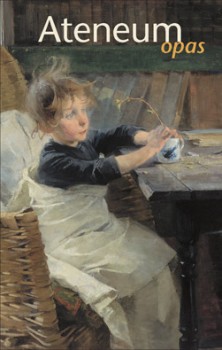
Helene Schjerfbeck’s The convalescent (1888) on the cover of the guidebook of the Ateneum Art Museum
Attention lovers of Finnish art: the Ateneum Art Museum in Helsinki has joined the international Google Art Project (begun in 2011), with 260 participating art institutes and more than 40,000 works of art as high-resolution images.
The website also includes information on the paintings. Among the 55 images from Ateneum on show now are many of the great works of the golden period of Finnish art (1880–1910), including Hugo Simberg’s darkly cute The Garden of Death, Albert Edelfelt’s heartbreakingly beautiful Conveying a Child’s Coffin, Akseli Gallen-Kallela’s classic portrayal of grief, Lemminkäinen’s mother, and – a personal favourite here at the Books from Finland office – Magnus von Wright’s evocative Annankatu Street on a Cold Winter’s Morning.
The Ateneum has few foreign works of art; in the Google Art collection now there are one Rodin, a Modigliani, a van Gogh and two Gauguins.
Forest and fell
8 May 2013 | Reviews

From North to South: young Heikki Soriola on his way to represent Utsjoki in Helsinki, in 1912. Photo from Saamelaiset suomalaiset
Veli-Pekka Lehtola
Saamelaiset suomalaiset: Kohtaamisia 1896–1953
[Sámi, Finns: encounters 1896–1953]
Helsinki: Suomalaisen Kirjallisuuden Seura, 2012. 528 p., ill.
ISBN 978-952-222-331-9
€53, hardback
Leena Valkeapää
Luonnossa: Vuoropuhelua Nils-Aslak Valkeapään tuotannon kanssa
[In nature, a dialogue with the works of Nils-Aslak Valkeapää]
Helsinki: Maahenki, 2011. 288 p., ill.
ISBN 978-952-5870-54-1
€40, hardback
The study of the Sámi people, like that of other indigenous peoples, has become considerably more diverse and deeper over recent decades. Where non-Sámi scholars, officials and clergymen once examined the Sámi according to the needs and values of the holders of power, contemporary scholarship starts out from dialogue, from an attempt to understand the interactions between different groups. More…
Inspired by winter
13 March 2013 | This 'n' that
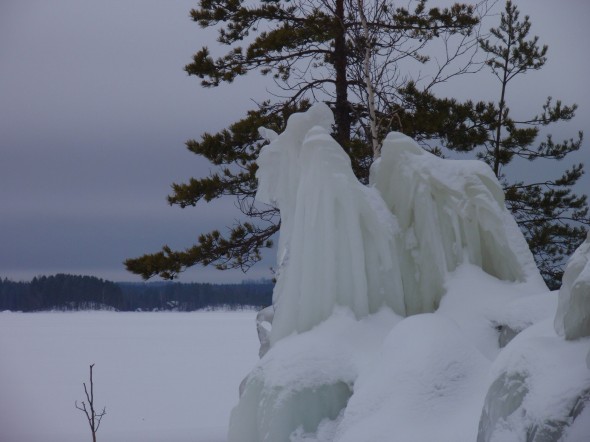
Made by nature: ice sculptures on Lake Saimaa. Photo: Soila Lehtonen
Jo kirkkahana aaltoo avaruus,
jo päivyt paistavi, jo hohtaa hanki,
vaan kaikkialla viel’ on hiljaisuus
ja taivas valju on ja maa on vanki.
Now bright swells in the heavens abound,
the days are sunny, snowdrifts gleam,
and yet silence still dwells all around,
the sky is pallid, a prisoner yet the soil.
We were so impressed by this astonishing ice sculpture, created by the artist Winter, that we wanted to share it with you – before, as the spring equinox has just been reached, it disappears for ever.
These hooded characters were created by the storm that sent waves up the trees growing on the waterfront of an islet, just before the lake Saimaa froze up late last year. They have been standing there for months, observed – and photographed – by hundreds of surprised skaters who pass them by on the 22-kilometre skating route.
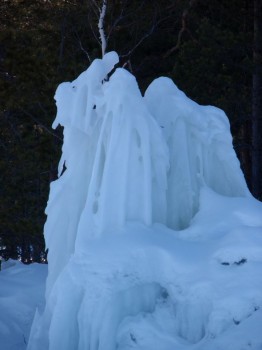
Bye-bye now…. Photo: Soila Lehtonen
Earlier these almost Biblical-looking figures seemed to be heading for south (the big photo), but as the changing temperatures and the March sun has now made their own adaptations in the marble-looking ice, the group now seems to be waving goodbye – until next winter, then?
The stanza is from the poem Maaliskuulla (‘In March‘, from the collection Maaliskuun lauluja, ‘Songs of March’, 1896) by Eino Leino (translation by yours truly).
More light! Mehr Licht!
10 January 2013 | In the news
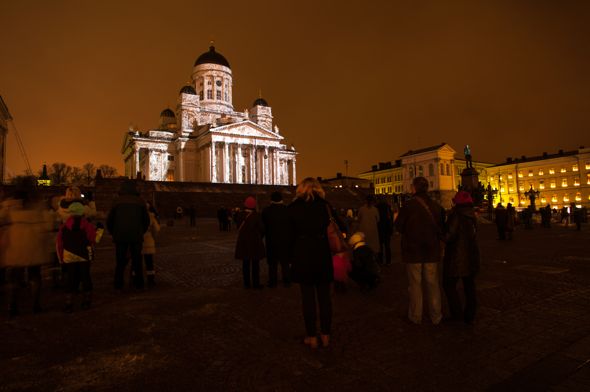
Light and colour: ‘Emergence’ by Casa Magica. Photo: Lux Helsinki / Hannu Iso-oja
With the winter solstice now over, the darkness will begin to diminish, albeit very slowly: additional artificial light is still much appreciated. Fiat lux! The early days of the new year Lux Helsinki (from 4 to 8 Jan) brought light and colour to the city-dwellers in the form of 13 light installations in various parts of the city.
The Cathedral was lit by the German duo Casa Magica – light designers Friedrich Förster and Sabine Weißinger – whose work entitled ‘Emergence’ painted the church with fantastic shapes and colours. One of the works was an illuminated, silvery tram – unfortunately it was not possible to get on board though.
Among the other works of light art was the recently opened and very popular Baana, an old train track now serving as a passageway for cyclists and pedestrians through the city centre: the creation entitled ‘Reveal’ by the London-based media artist Dan Shorten made the stone walls change colour and the total mood of Baana.
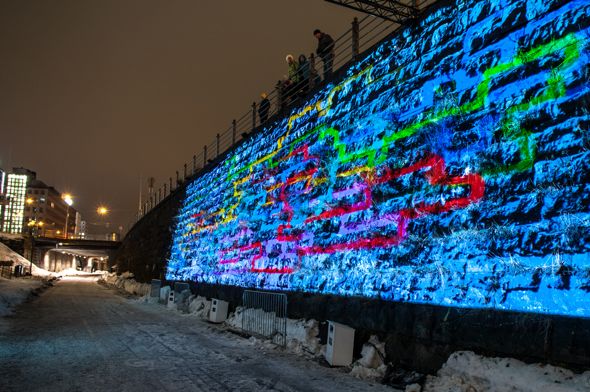
Paint with colour: ‘Reveal’ by Dan Shorten. Photo: Lux Helsinki / Hannu Iso-oja
A pity Lux Helsinki – staged now for the fifth time – lasts for a few days only, as it will take a while for the increase of daylight to be apparent….
Form follows fun
4 December 2012 | Non-fiction, Reviews
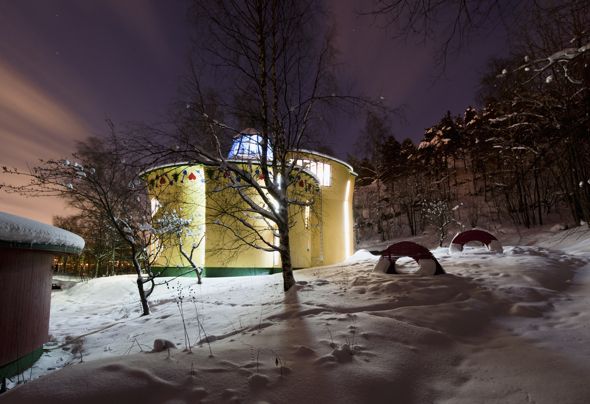
The house that the artist built: ‘Life on a leaf’ (2005–2009, Turku). Photo: Vesa Aaltonen
Jan-Erik Andersson: Elämää lehdellä [Life on a leaf]
Helsinki: Maahenki, 2012. 248 p., ill.
ISBN 978-952-5872-82-4
€42, hardback
‘I am Leaf House –
root house, sky house.
Enter me, be safe
And wander, dream.
The artist’s I is all our eyes….’

In the garden: red ‘apple’ benches designed by the English artist Trudy Entwistle. Photo: Matti A. Kallio
We all live – exceptions are really rare – in cubes. Not in cylinders or spheres, let alone in buildings of organic shapes like flowers or leaves; and houses in the shape of a shoe, for example, belong to the fairy-tale world, or perhaps to surrealism.
Artist Jan-Erik Andersson wanted to build a fairy-tale house in the shape of a leaf, and that is what he did (2005–2009), together with his architect partner Erkki Pitkäranta. Instead of the geometry of modernist architecture, he is inspired by the organic forms of nature.
Andersson’s house project, entitled ‘Life on a leaf’, also became an academic project, resulting in a dissertation at Finnish Academy of Fine Arts and now a book, including a detailed journal of the building process itself. The artist was at first advised, by a professor of architecture, not to proceed with his building project – he wouldn’t ‘like living in the house’, he was told. More…
How cool is Stinky?
30 November 2012 | This 'n' that
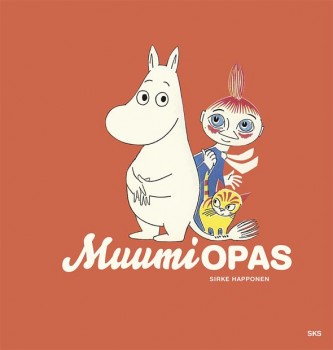
Moomintroll and Mymble: positive role models
‘What reigns in Moomin Valley is a rock-hard hierarchy of those who are cool (Snufkin, Moominmamma, Little My), those who need to be those who are cool (Moomintroll, the Snork Maiden, Sniff, one or two Whompers and Toffles), and those who are absurd (the Hemulen, the Fillyjonk, the Muskrat)’, noted Pia Ingström in her review (Books from Finland 2/2008) of Sirke Happonen’s dissertation on Tove Jansson’s characters.
Snufkin? Fillyjonk? The Moomin world, created by the versatile Finland-Swedish writer and artist Tove Jansson (1914–2001), is peopled with funny-shaped Moomins and a great variety of other creatures who may look a bit odd at first but who are very… human. Jansson’s books have been translated into more than 40 languages. More…
Renaissance man
19 November 2012 | This 'n' that
 The graphic designer Professor Erik Bruun has been awarded the Helsinki Design Award, created to celebrate World Design Capital Helsinki 2012.
The graphic designer Professor Erik Bruun has been awarded the Helsinki Design Award, created to celebrate World Design Capital Helsinki 2012.
Worth 10,000 euros, this special one-off award is intended to highlight the remarkable work of Erik Bruun (born 1926). His internationally recognised life’s work – from the 1950s onwards – includes commercial posters, book and journal design, logotypes, postage stamps and bank notes, photography and nature posters. Recently his best designs of the 1950s have been experiencing a renaissance as, for example, printed material and posters.
Finnish nature, its flora and fauna, in particular endangered species, have been close to his heart, and his Saimaa ringed seal poster became the emblem of the Finnish Association for Nature Conservation.
Erik worked with us at Books from Finland as Art Editor from 1976 to 1990. He has lived for decades in an old wooden house on the UNESCO World Heritage Site islands of Suomenlinna (Sveaborg) in Helsinki harbour, and his observations of his winged friends, various sea birds, were often the subject of discussion over Books from Finland layouts.
The logo he created for Books in 1978, a quill with an eagle’s eye, featured on the covers of almost 50 issues of the journal; the illustration here, with the text Images from Finland, is from a catalogue introducing graphics and poems from a portfolio published by Eurographica in 1978.
Our editorial process went digital in the early 1990s – but Erik still works with his quills and pens, not with computers.
Congratulations!
